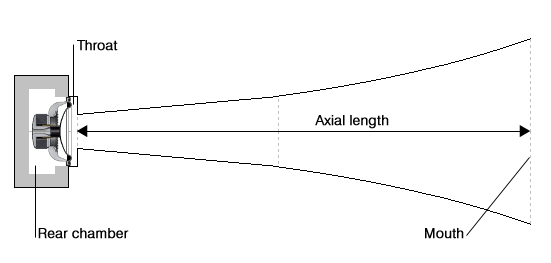
First, download it here:
Hornresp download >
We'll design a front loaded horn.
1. Choose your driver and enter in it's parameters:
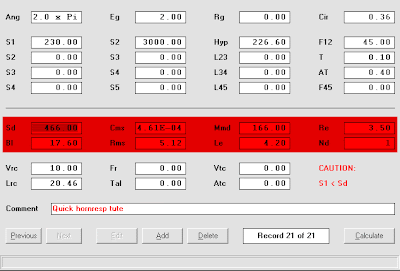
I've entered TS parameters for the Peerless XLS driver. Use mms for mmd. If you don't have either Rms or Cms, they can be calculated. Select Tools/Calculate parameter.
2. Enter Ang and Eg
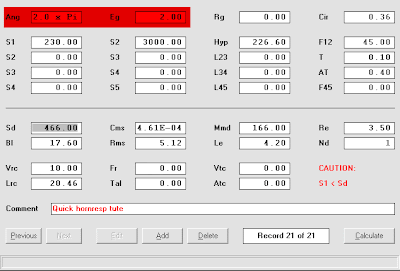
Ang: double click until it cycles through to 2pi. This means it will correspond to simulations you would get in programs like WinISD. Otherwise you get an exaggerated output figure.
Eg: double click then enter the nominal impedance of the driver. You will now see the efficiency with 1w of input with simulations.
3. Auto generate horn
Select Tools/System design/with driver
In this case, let's choose 40 - 150 Hz. Now you weill notice that fields are filled in:
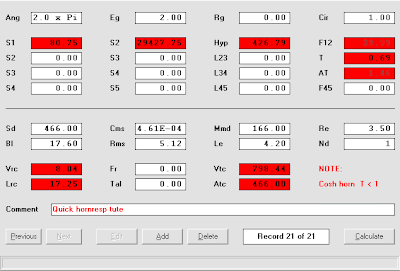
Press calculate and view the results:
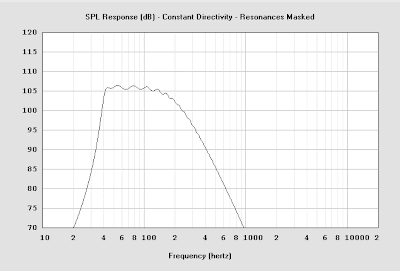
This is a very good result with very high efficiency of around 106 db 1w1m. Normally this driver would have an efficiency around 87 db so we have gained around 19 db. Make sure you use the correct values of Ang and Eg or the efficiency will not be correct.
The schematic shows that the horn is over 2000L in volume! This is too big to be practical and the compression ratio is too high. Compression ratio is SD : S1 and should be 2 for a conventional driver. Now we need to modify the horn to get it down to a practical and workable solution.
4. First attempt at changing some numbers
Remove the throat chamber - enter zero for both Vtc and Atc.
Increase the size of the rear chamber to 15L
Set S1 to half the value of SD
Double click on hyp and a box will open up:
Choose a value for S2 that isn't crazy. This is the mouth area. Use a calculator and work it out in cm. I'll choose 50 cm wide x 120 cm high which gives 6000 cm2.
Now click on L12 - this is the length. We'll let hornresp calculate this based on F12 which is the number we'll input for our cut off - 40 Hz. We hope to get the horn to extend to this point. Select calculate and it works out the length. Now click save and the new numbers are entered:
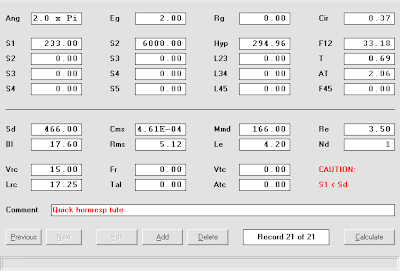
Now click calculate to see the new results.
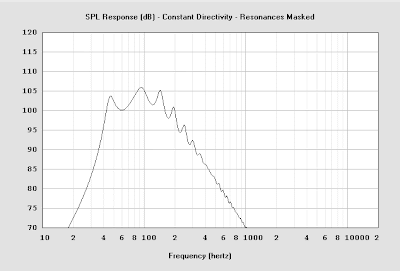
Not quite as impressive as before but we have maintained the extension and efficiency except for a midbass dip and the volume is now around 500L.
Let's simulate for corner loading. Change Ang to 0.5 and for Eg double click again and input 0.0625w. This compensates for 12 db of acoustic gain that inflates the efficiency.
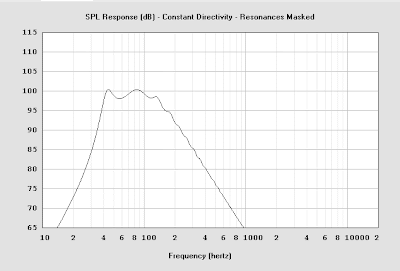
Now we have decent performance and it's smooth enough. There isn't much need to try to get it flatter as room response will do much worse. Efficiency has dropped off a little but it's still very high.
Further tweaking
You might like to experiment with different sizes for the rear compression chamber. You will see a change in the excursion chart - a smaller size will cause a sharper peak and lower excursion. A larger size will see a plateau rather than a sharp peak. You will also see a change in the response where a smaller chamber gives a small peak in the bottom end and a larger chamber sees a rounded knee and often slightly less efficiency.
If you've measured the transfer function of your room, then you have some useful info. Suppose you had a 10 db peak at 30 Hz. You could lower the cut off and it would probably work with the gain better, extending the in-room result down to 30 Hz. If you are designing for a particular room, it's very helpful to have this information and incorporate it into the design.
Next: see how you can get better results >

hi, can u please tell me were to get the hornresp,please.
ReplyDeleteYou can find it here:
ReplyDeletehttp://www.hornresp.net.ms/
Hi Paul, I seem to remember seeing somewhere that you were going to do a tutorial on folding a bass horn. Did that ever get written?
ReplyDeleteI've built a number of different bass horns from various available designs, and have been playing with hornresp (thanks for your tutorials!) to design something from scratch. but folding is something I haven't been able to get my head around to my satisfaction - ive hunted down all I can on the internet on the subject, but most of it looks like rule of thumb stuff - nothing seems to be based on any solid theory other. ive played with cutout bits of paper, drawings in CAD, but every method i've looked at, I can see holes in. Is there anything in the way of theory, or at least practice backed by sound principles?
cheers, Ben
Hi Ben,
ReplyDeleteThat one is on page 2,000,456 of my to do list!
With Red Spade Audio, I now do horn designs as custom work.
My quick suggestion for you. Design it in hornresp and settle on a design that works and has a volume you can live with. Work out the folds in CAD, then build it and measure it nearfield in the mouth, see what you learn. Export your hornresp sim into REW and measure with REW to get a comparison.
working out the folds in CAD is where I am at the moment - my current method involves drawing a centreline down the middle of the horn (assume its a rectangular crossection with a constant width, which reduces it to a 2D problem). I'm slicing the horn through at the point I want to fold, then rotate about the point where the slice crosses the centreline. one side of the hornpath gets shorter and the other longer, effectively, but the path length at the centre of the horn is preserved. does this seem a reasonable approach? or have I missed something fundamental? if you know of any literature or references on the subject of horn folding, let me know. cheers
ReplyDelete